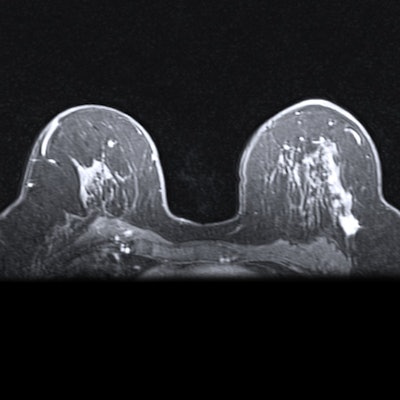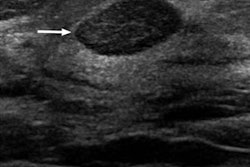
Major cancer organizations recommend interval MRI screenings for women with a breast MRI finding likely to be benign. But are these follow-up screenings of BI-RADS category 3 patients effective for catching cancer? New research published in the February issue of the American Journal of Roentgenology shows they are -- to a certain extent.
The cancers diagnosed on MRI follow-up screenings of BI-RADS category 3 lesions are often staged 0 to 1 thanks to prompt detection. However, BI-RADS 3 may be better for classifying lesions found during initial MRI sessions than those found at follow-up sessions.
"When used judiciously, short interval follow-up MRI is an appropriate method for identifying early-stage breast cancer while avoiding unnecessary biopsies with benign findings," wrote the authors, led by Dr. Christine Edmonds from the Massachusetts General Hospital Department of Radiology (AJR, February 2020, Vol. 214:2, pp. 240-248).
BI-RADS category 3 denotes lesions that are likely benign but have a small risk of being cancerous. For women with BI-RADS 3 findings, various organizations recommend follow-up MRI imaging at six, 12, and 24 months to watch lesion progression.
To see if these intervals are actually effective at catching cancer, the researchers looked at data from more than 6,600 women who were deemed at a high risk for breast cancer and received supplemental screening breast MRI.
MRI screening resulted in a BI-RADS category 3 assessment for 202 (3%) of all women in the study. On follow-up screenings, 13 women with a BI-RADS category 3 assessment were eventually diagnosed with cancer.
| Characteristics of 13 cancer cases followed up from BI-RADS 3 assessment | ||||
| Screening indication | Time to diagnosis (months) | Mode of diagnosis | Stage at diagnosis | |
| Case 1 | High-risk lesion | 6 | Follow-up MRI | 0 |
| Case 2 | Personal history | 13 | Follow-up MRI | 0 |
| Case 3 | High-risk lesion | 24 | Screening MRI | 0 |
| Case 4 | BRCA mutation | 2 | Diagnostic mammography and ultrasound | I |
| Case 5 | Personal history | 3 | MRI biopsy | I |
| Case 6 | Personal history | 3 | Diagnostic mammography and ultrasound | I |
| Case 7 | Personal history | 6 | Follow-up MRI | I |
| Case 8 | Personal history | 6 | Follow-up MRI | I |
| Case 9 | Personal history | 6 | Follow-up MRI | I |
| Case 10 | Personal history | 6 | Follow-up MRI | I |
| Case 11 | Family history | 7 | Follow-up MRI | I |
| Case 12 | Personal history | 11 | Follow-up MRI | I |
| Case 13 | Personal history | 6 | Follow-up MRI | III |
The vast majority of cancers detected on follow-up MRI imaging were early-stage, node-negative cancers at diagnosis. The interval screenings also helped an additional 189 patients, or 2.8% of the full patient population, avoid an unnecessary biopsy.
"Our data suggested that we may safely observe BI-RADS 3 MRI lesions and accept a higher malignancy rate without risking diagnosing malignancy at more advanced stages," the authors wrote.
Women with a baseline MRI screening had four times greater odds of a BI-RADS 3 assessment after the researchers adjusted for age, breast density, and other confounding factors. The researchers wondered whether the results suggest that an assessment of BI-RADS 3 may not be as useful for ruling out cancer during follow-up MRI screenings.
"Although use of BI-RADS 3 for baseline examinations yields an acceptably low malignancy rate, further investigation is warranted to determine whether there is an appropriate role for safe use of BI-RADS 3 for nonbaseline examinations, perhaps based on specific lesion features, or whether BI-RADS 3 should be used exclusively in baseline examinations," the researchers wrote.
The study had some shortcomings, including that all patients were seen at one academic institution, so the results may not translate to other types of screening centers. In addition, the patients were all at an increased risk of breast cancer, and the findings may not apply to patients with lower breast cancer risk.
The results demonstrated that interval screenings for women with a BI-RADS category 3 finding can help prevent healthy women from having biopsies without increasing the risk of late-stage diagnosis for women with cancer. The researchers hope future studies continue to investigate whether BI-RADS 3 is a useful assessment during follow-up MRI screenings.
"Given that most cancers diagnosed during follow-up of BI-RADS 3 lesions are early stage, there is strong evidence that judicious use of short-interval follow-up MRI is an appropriate method for identifying early-stage breast cancer while avoiding unnecessary biopsies of benign breast lesions," the authors concluded. "However, greater prudence is warranted in the assessment of BI-RADS category 3 in nonbaseline examinations, and further investigation is warranted to better guide appropriate utilization."



















